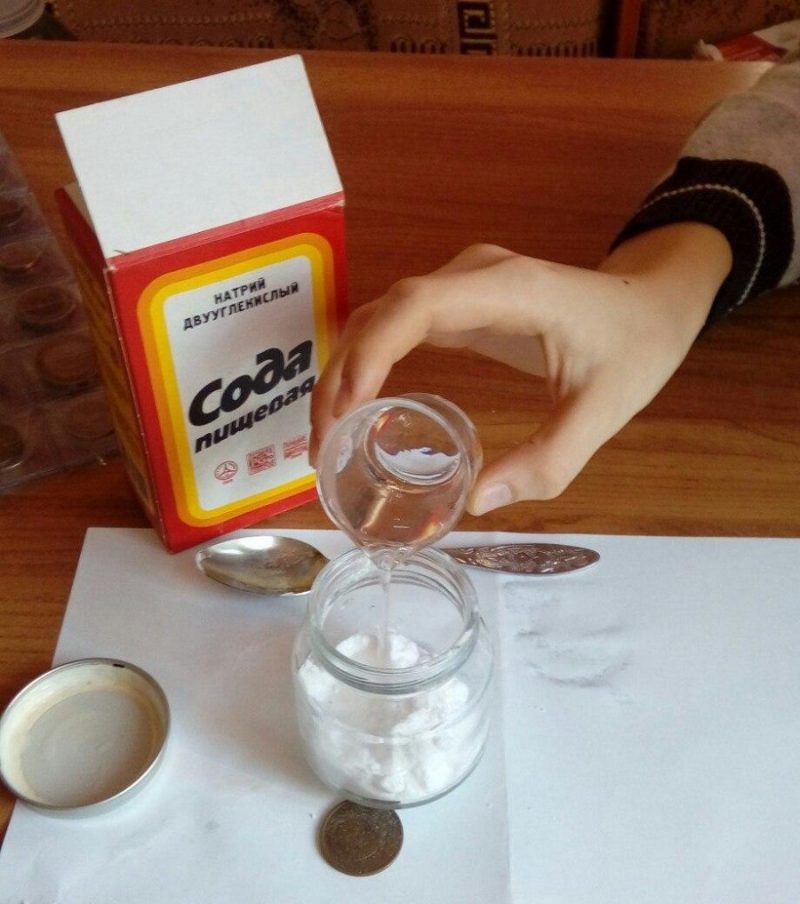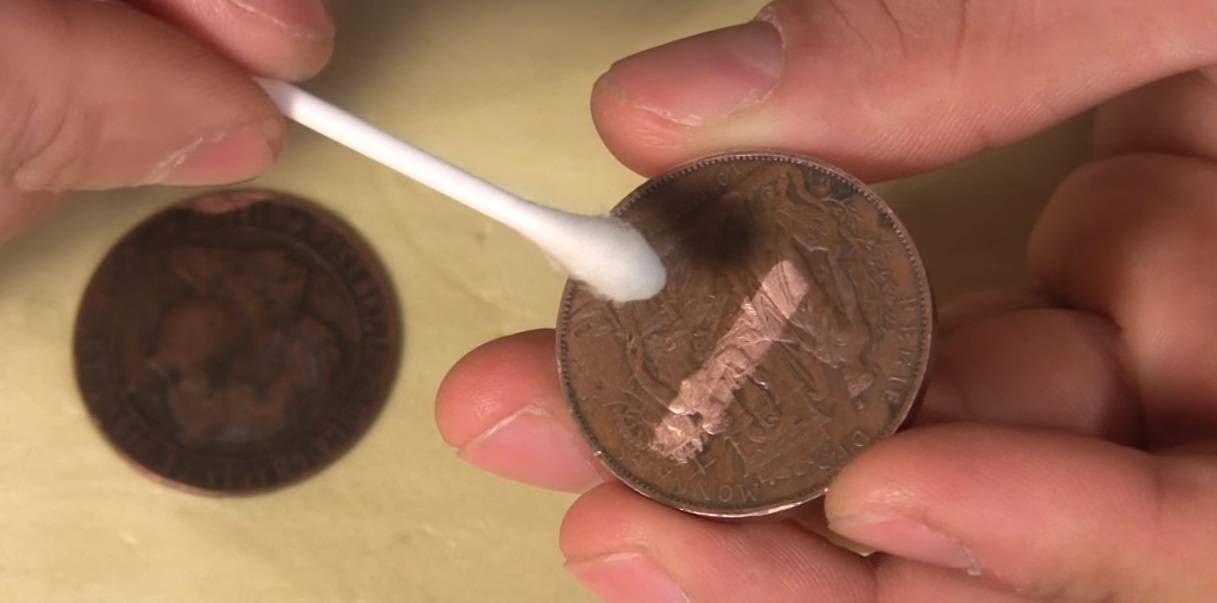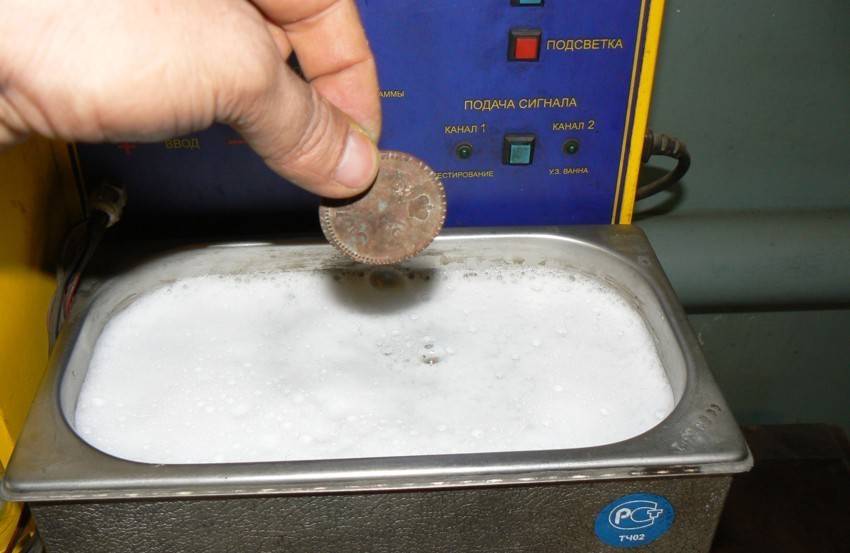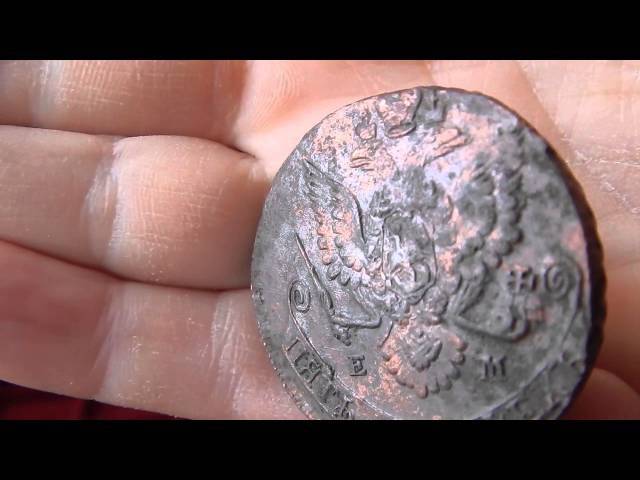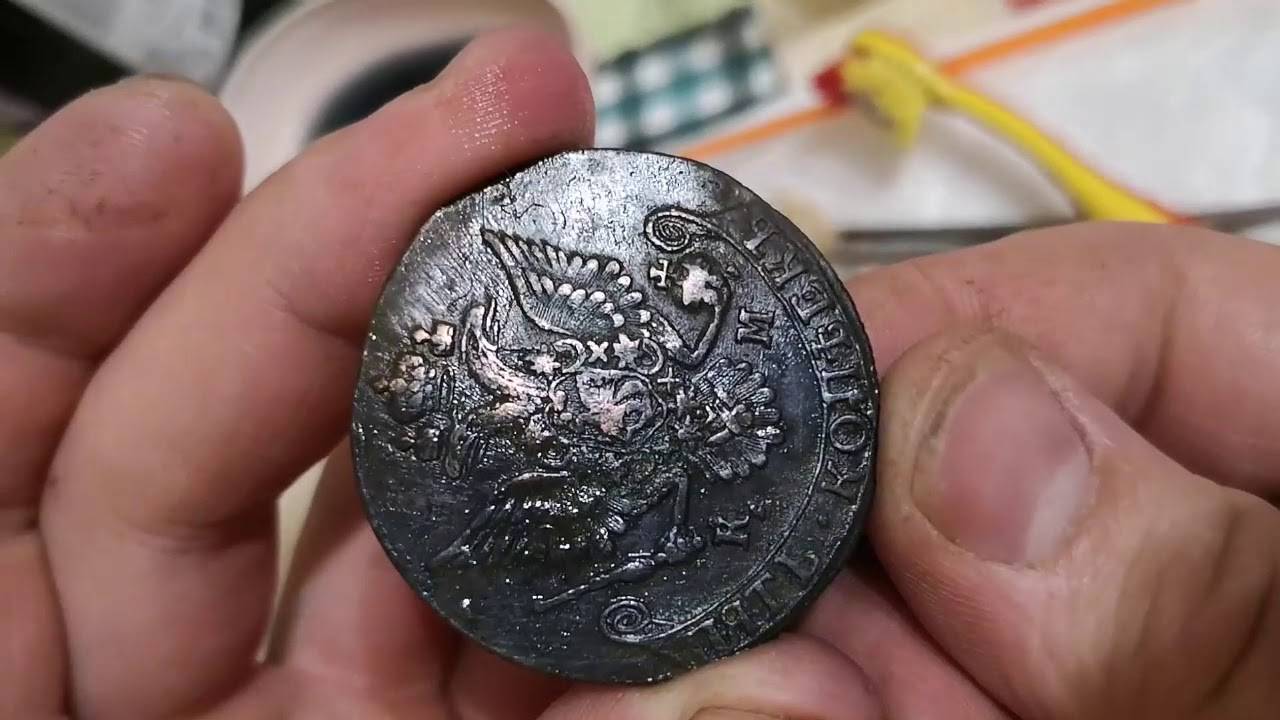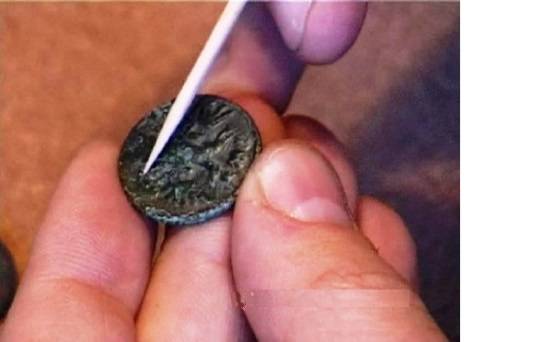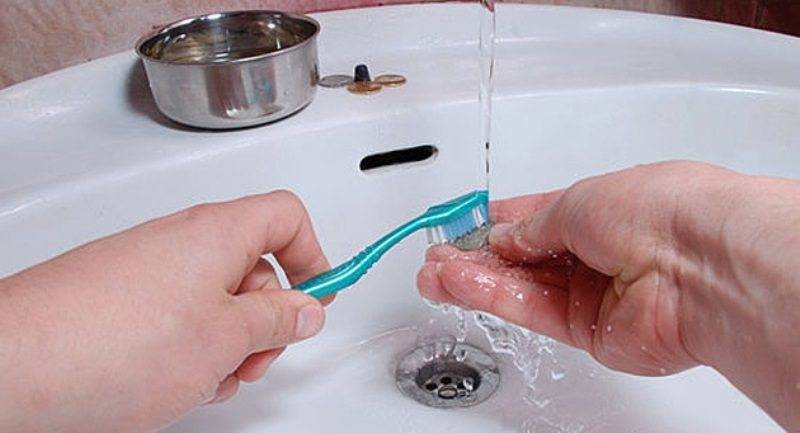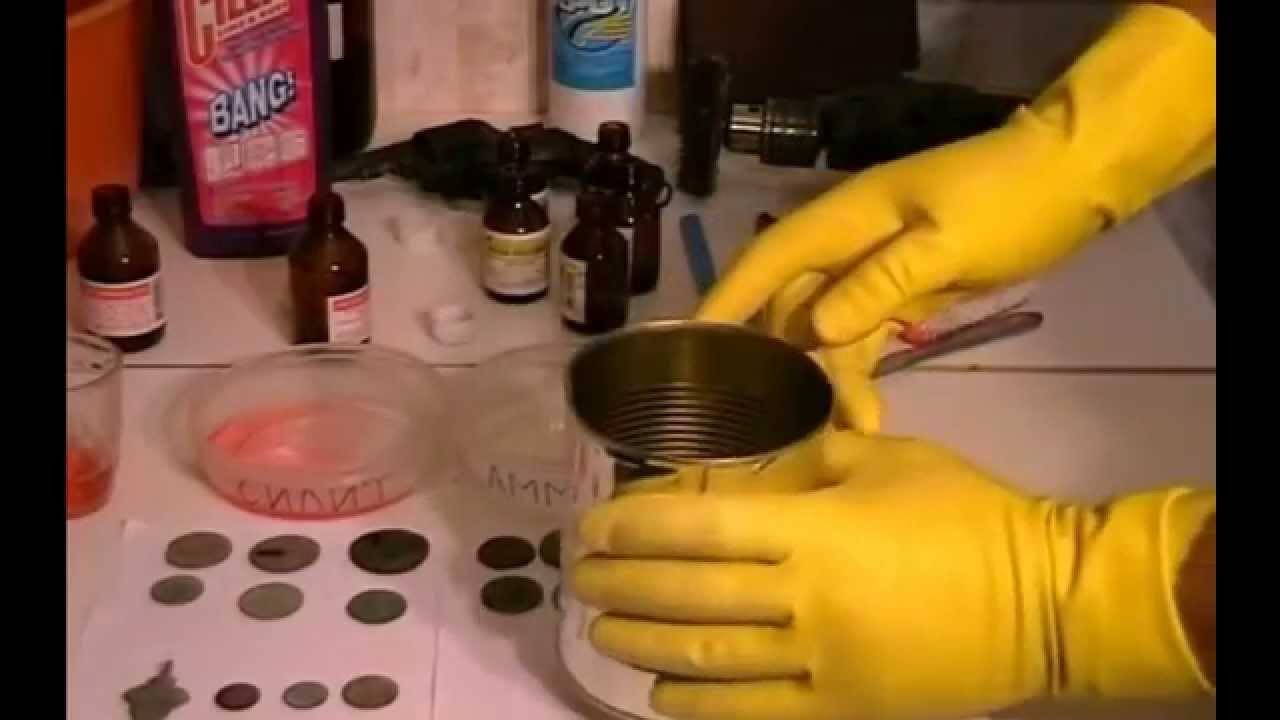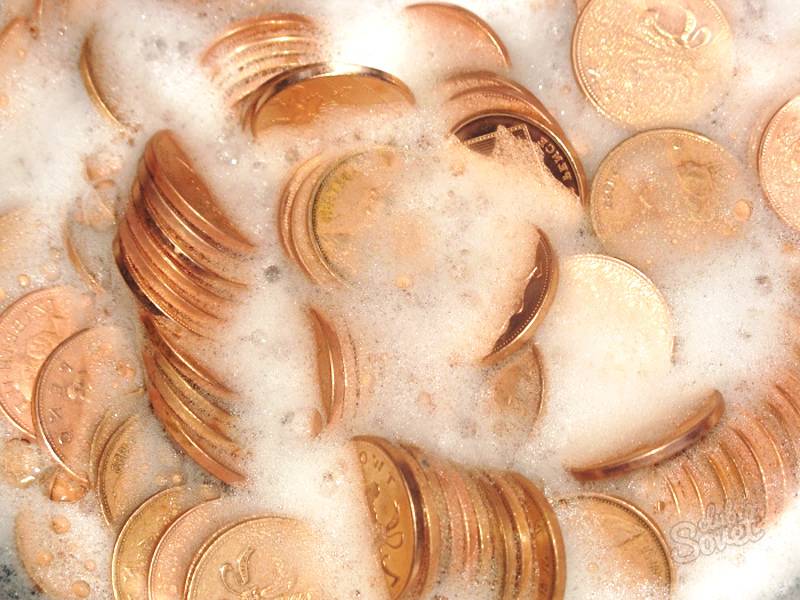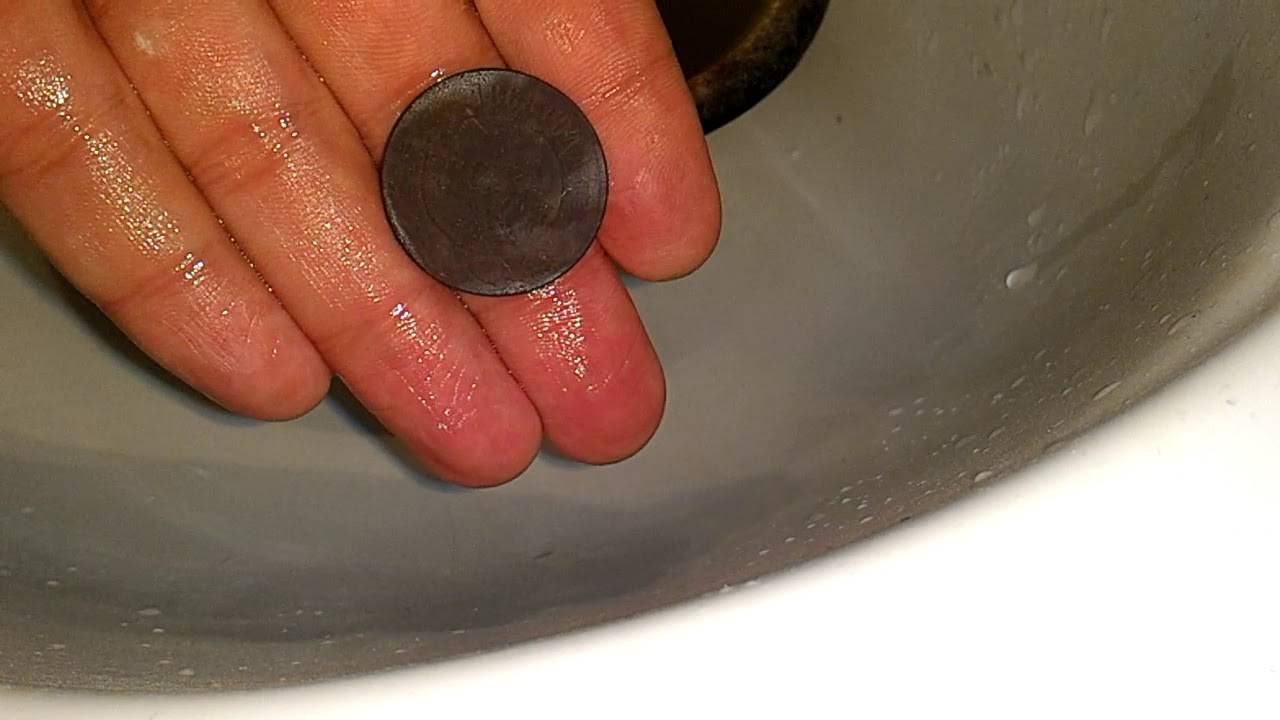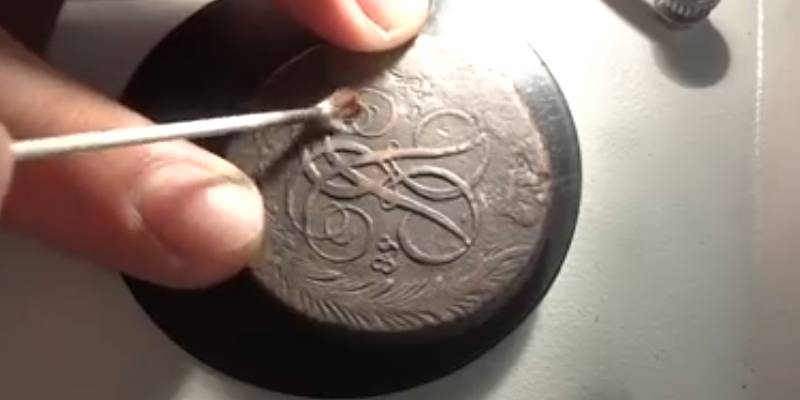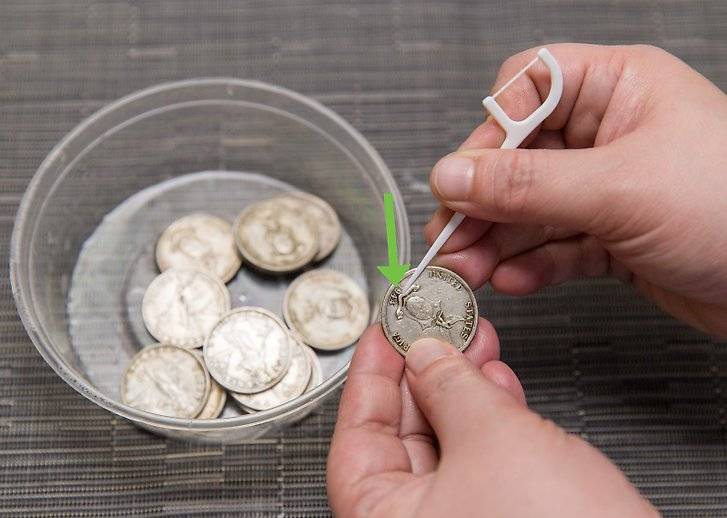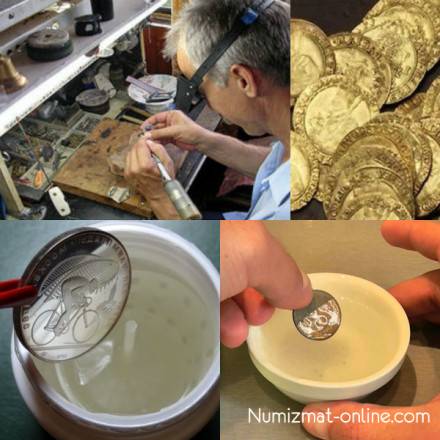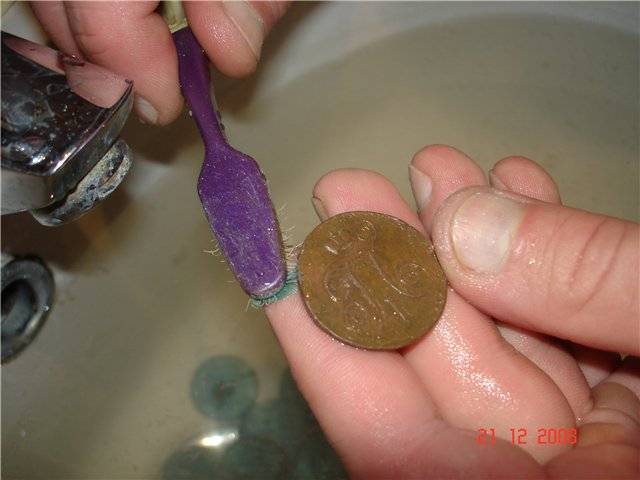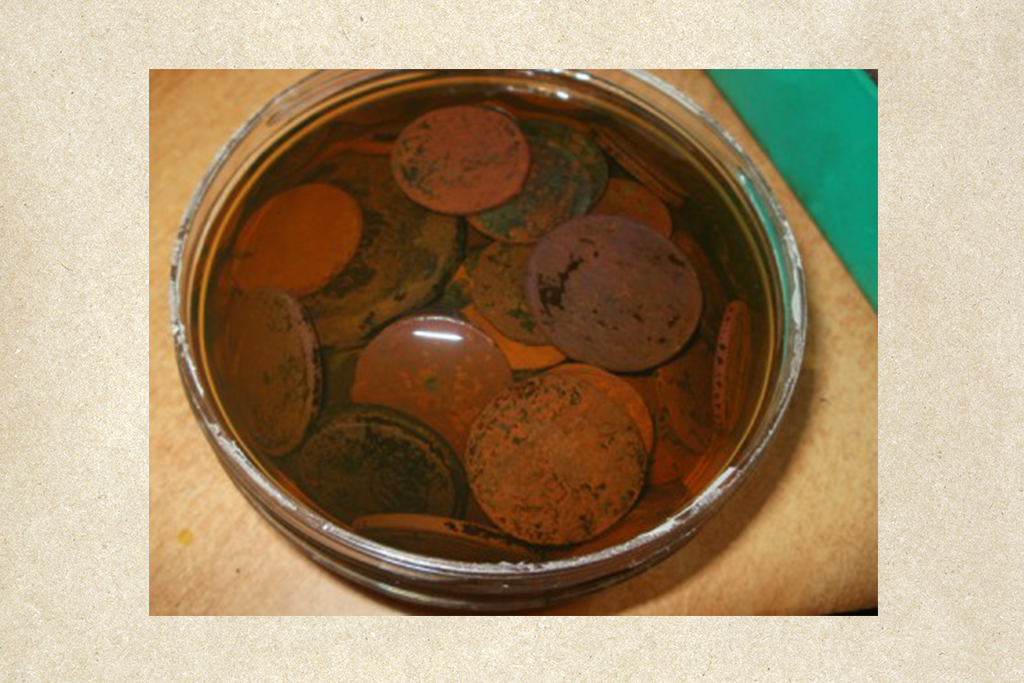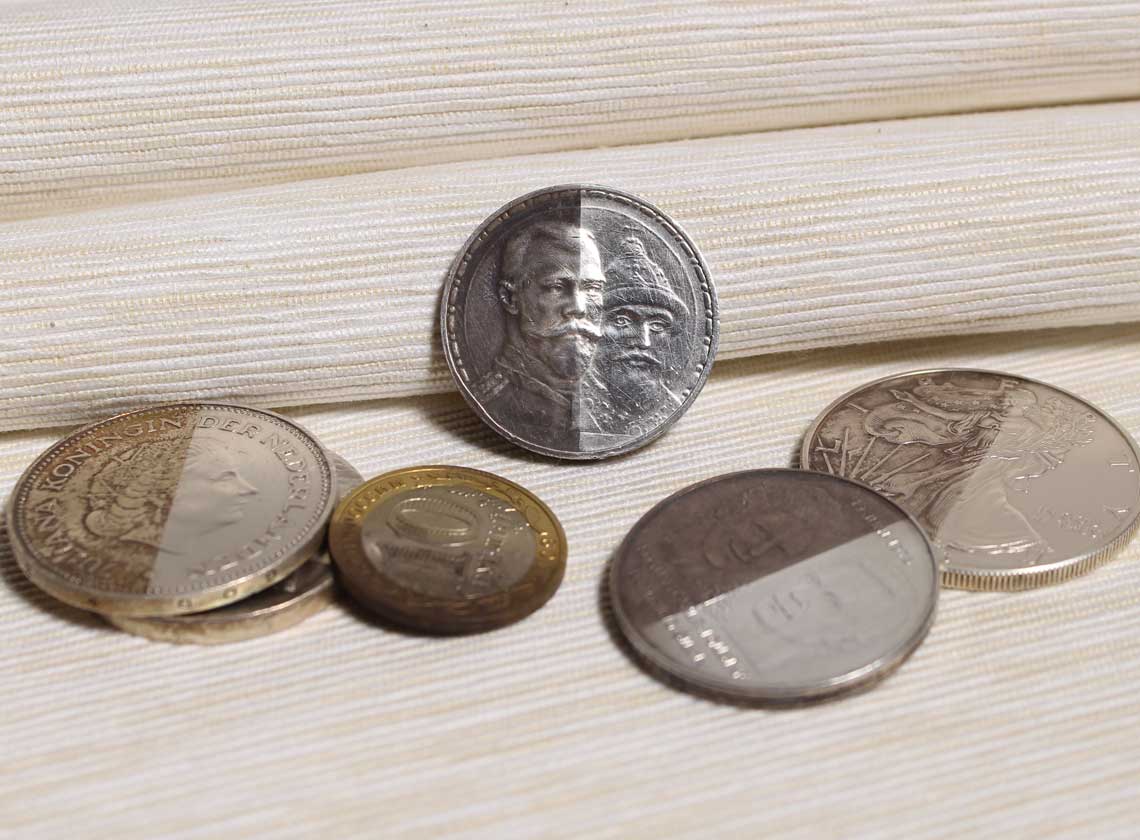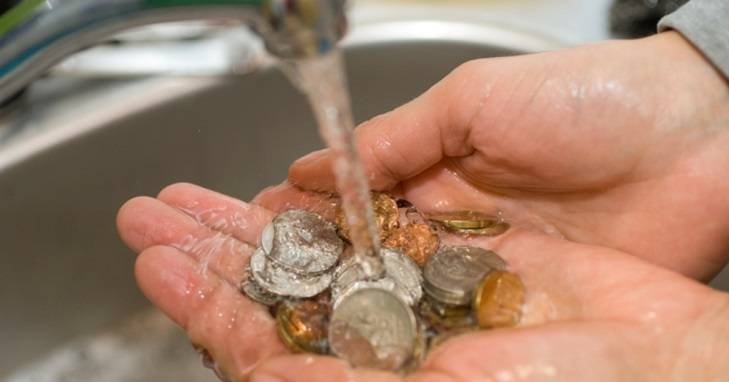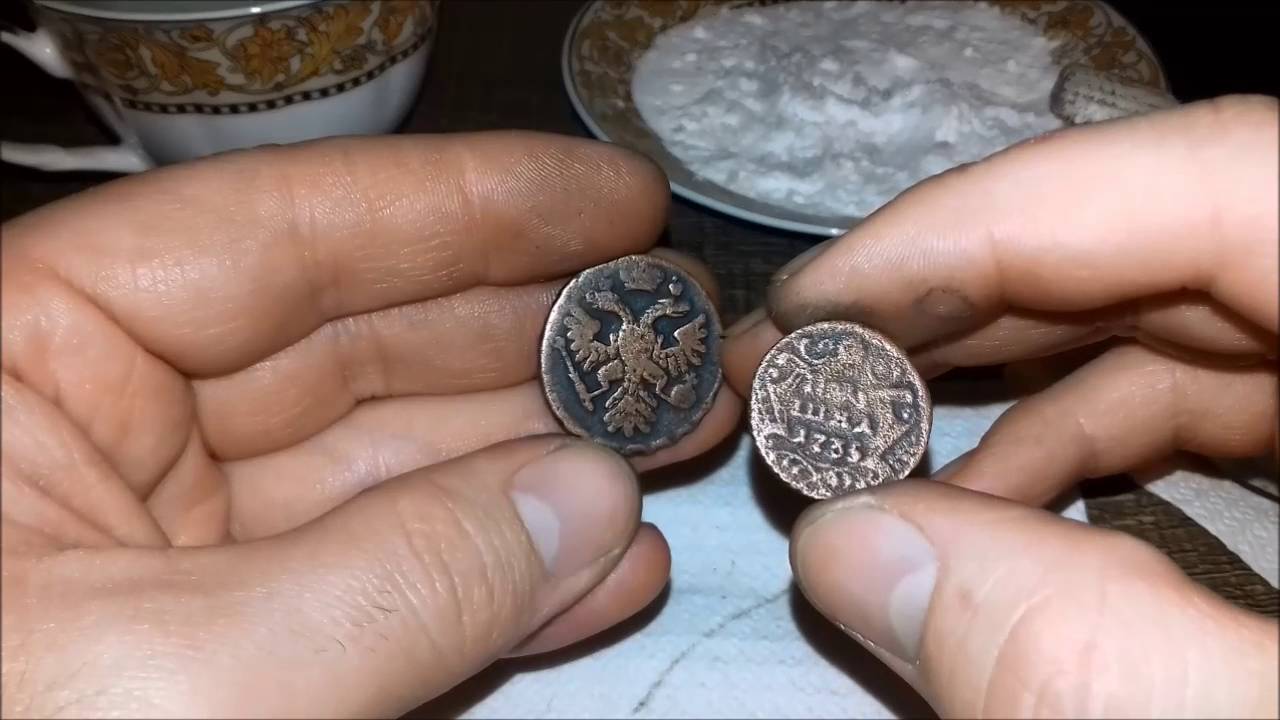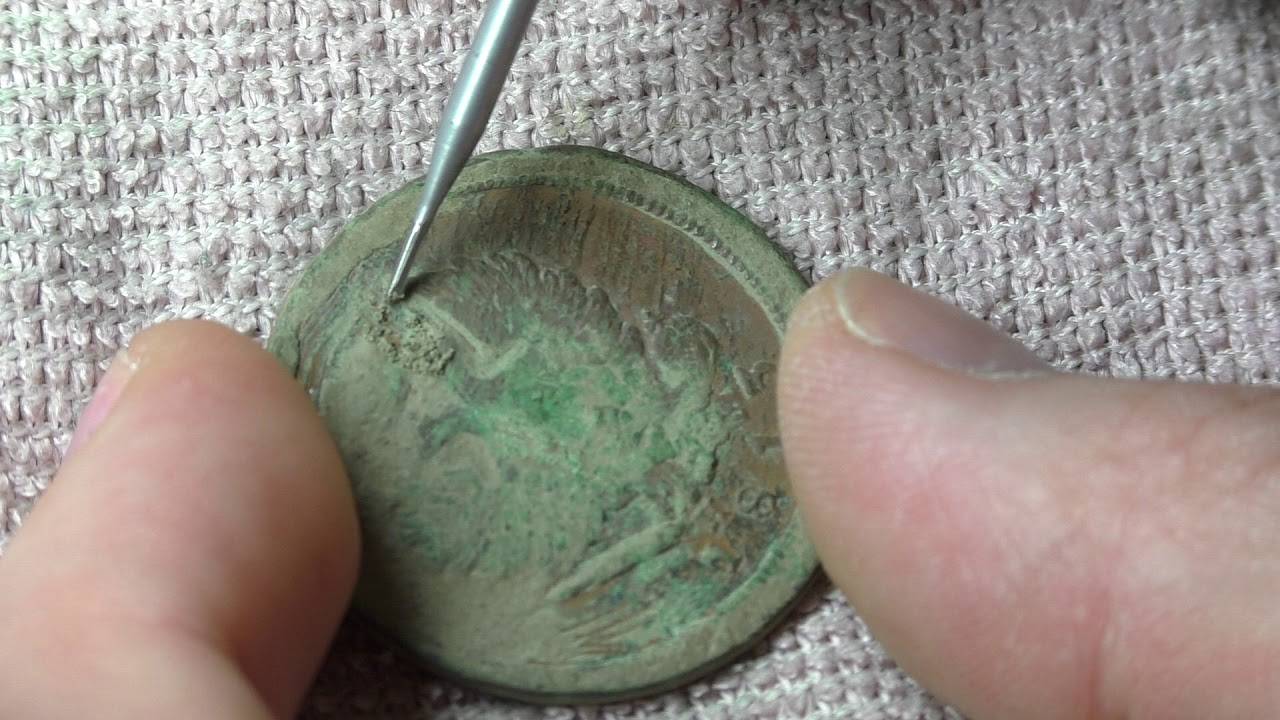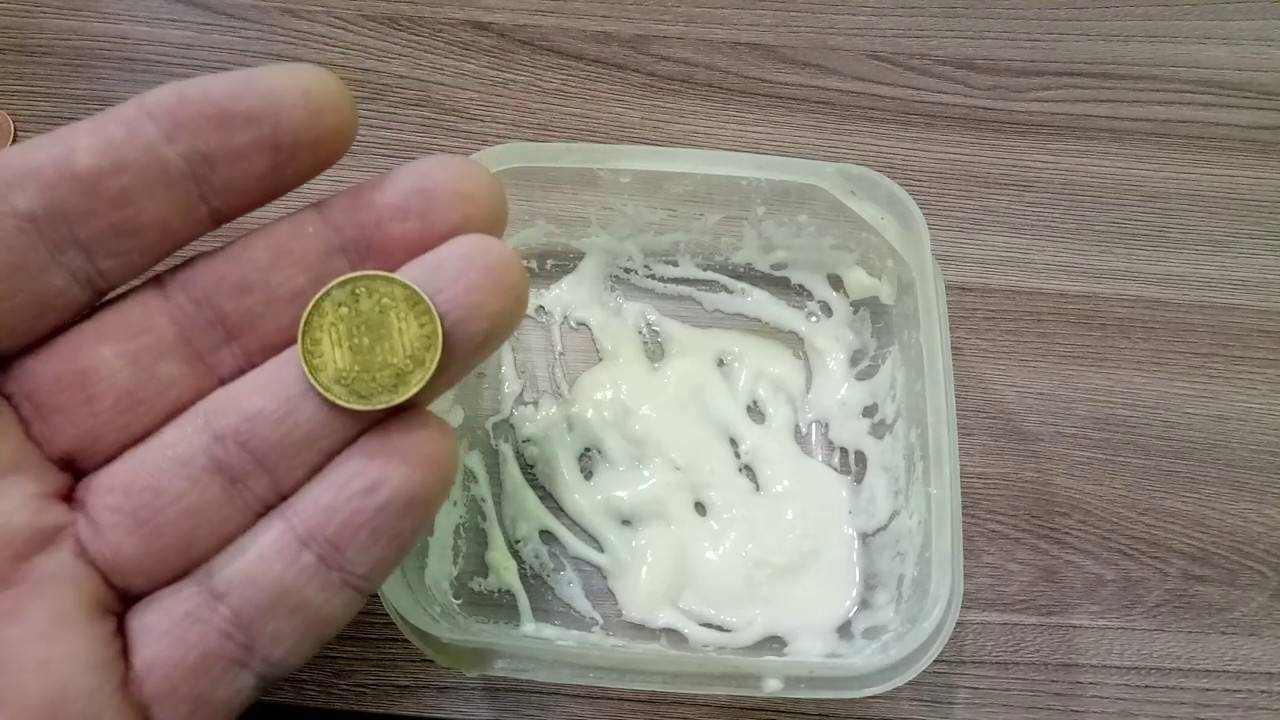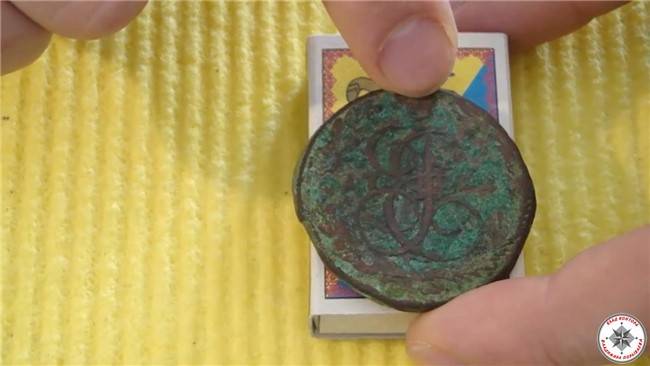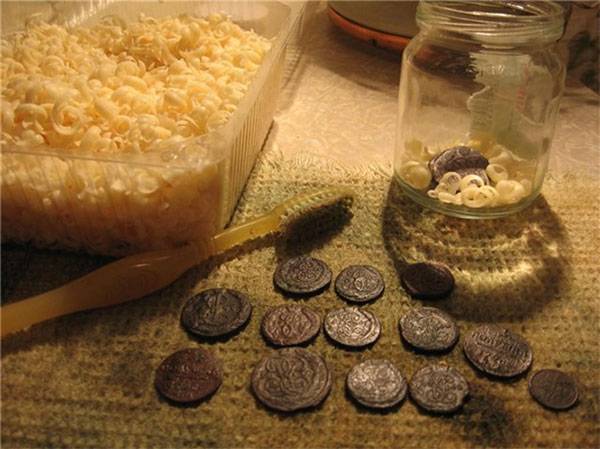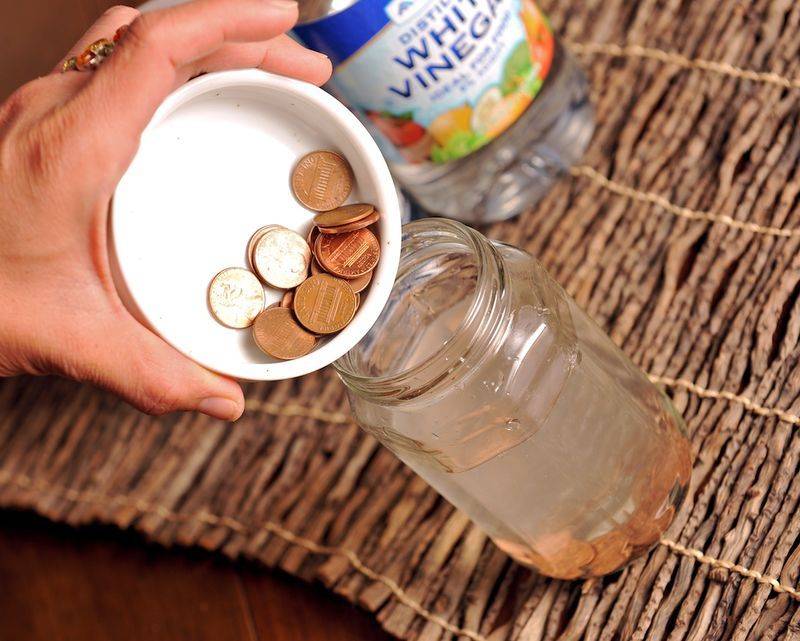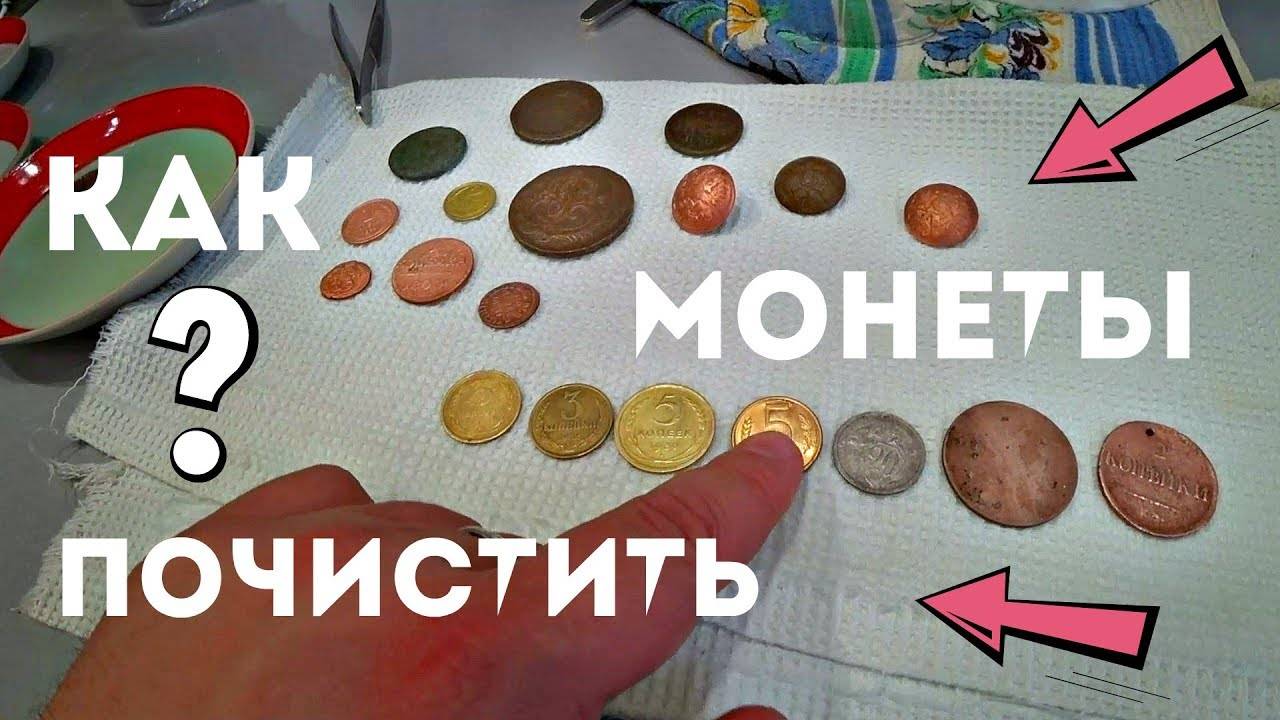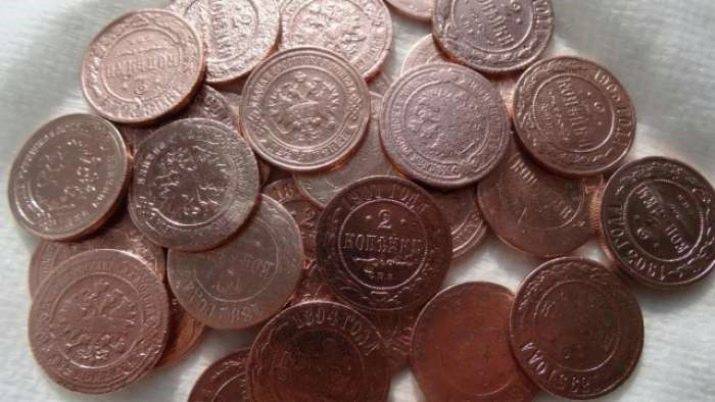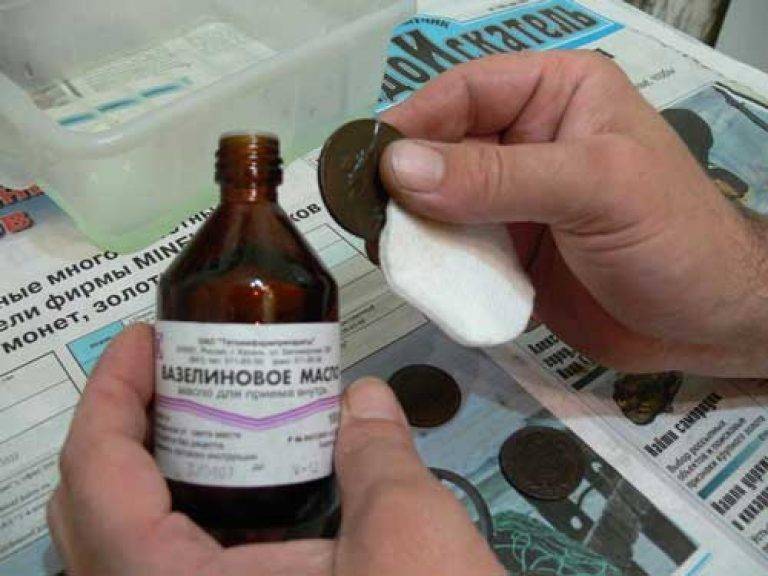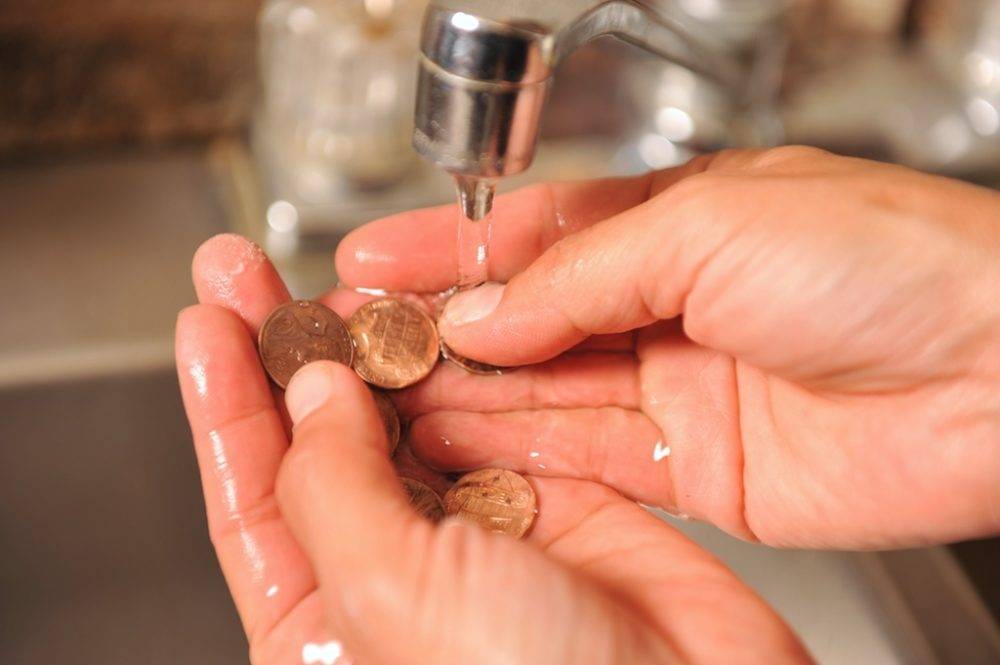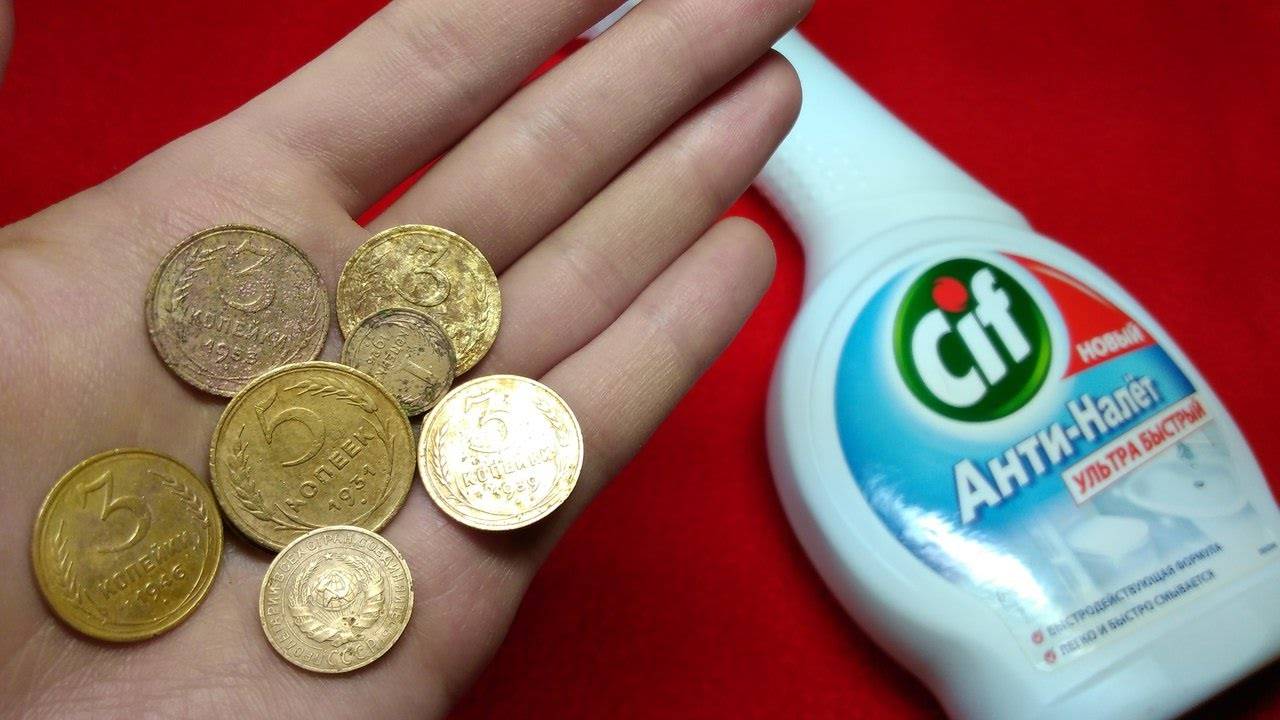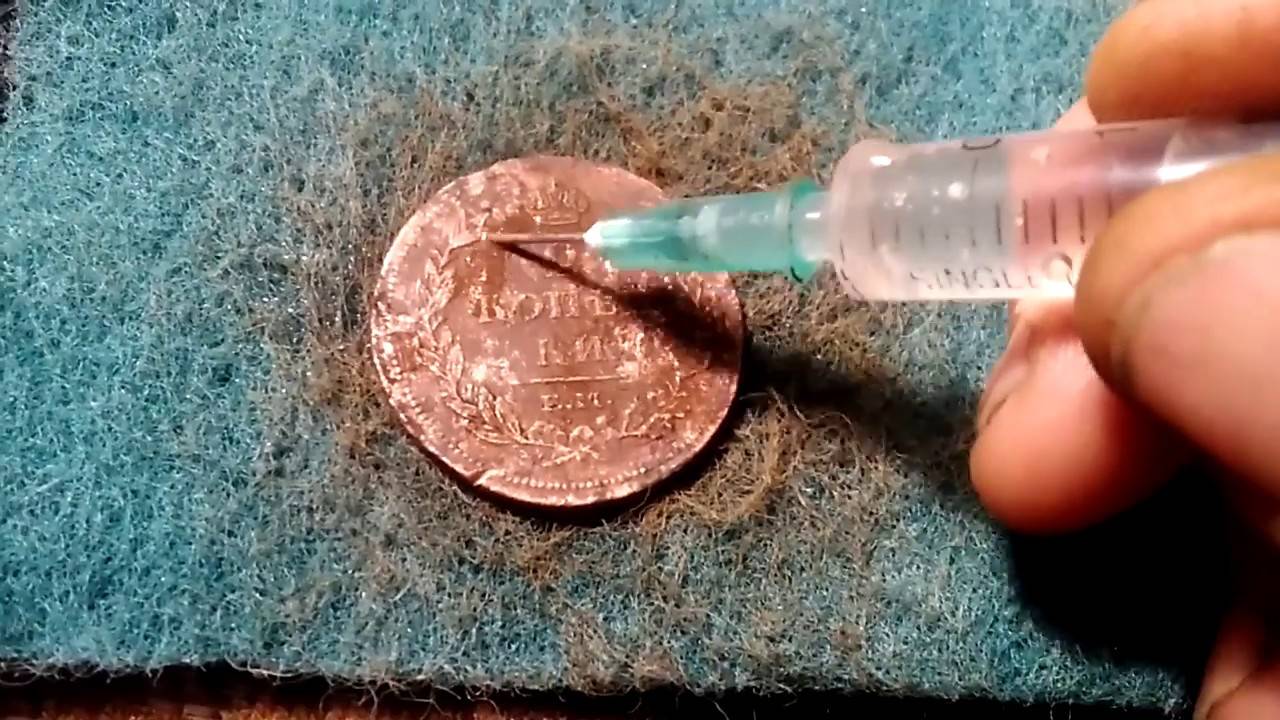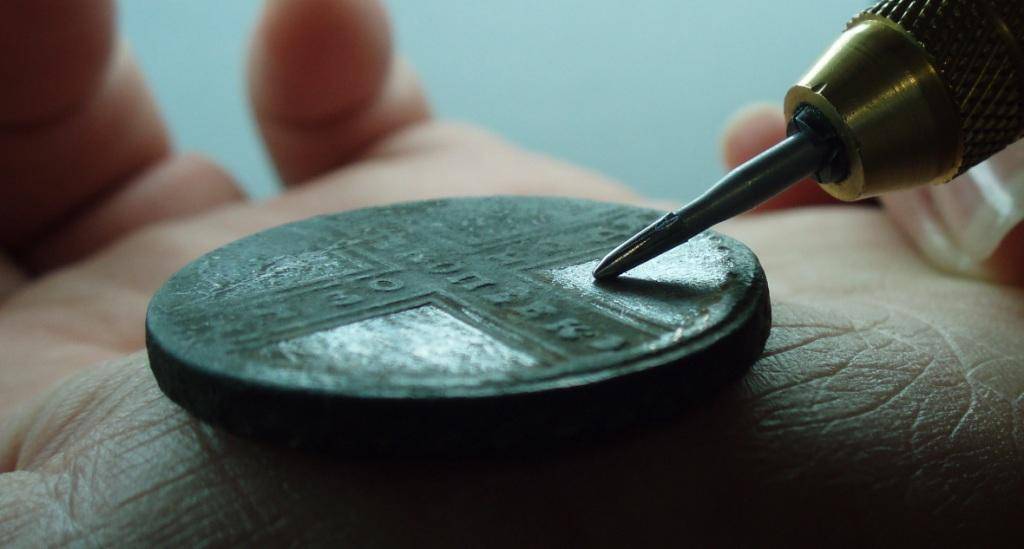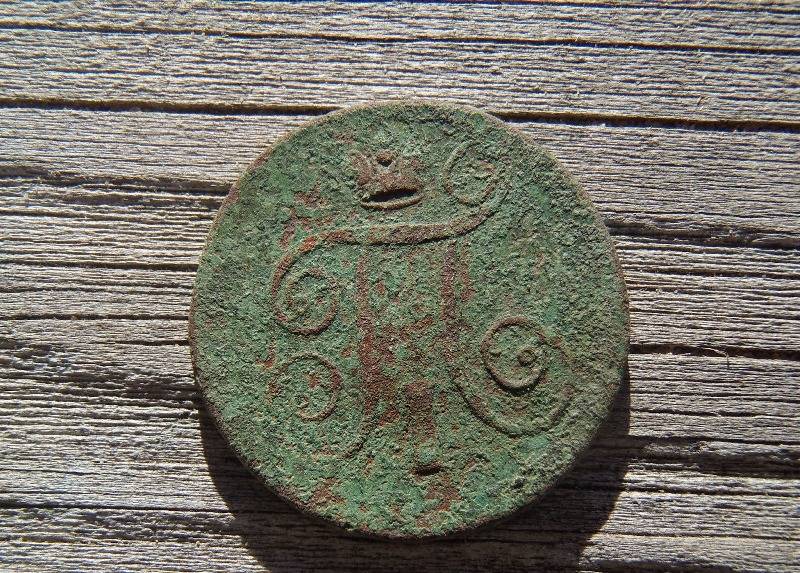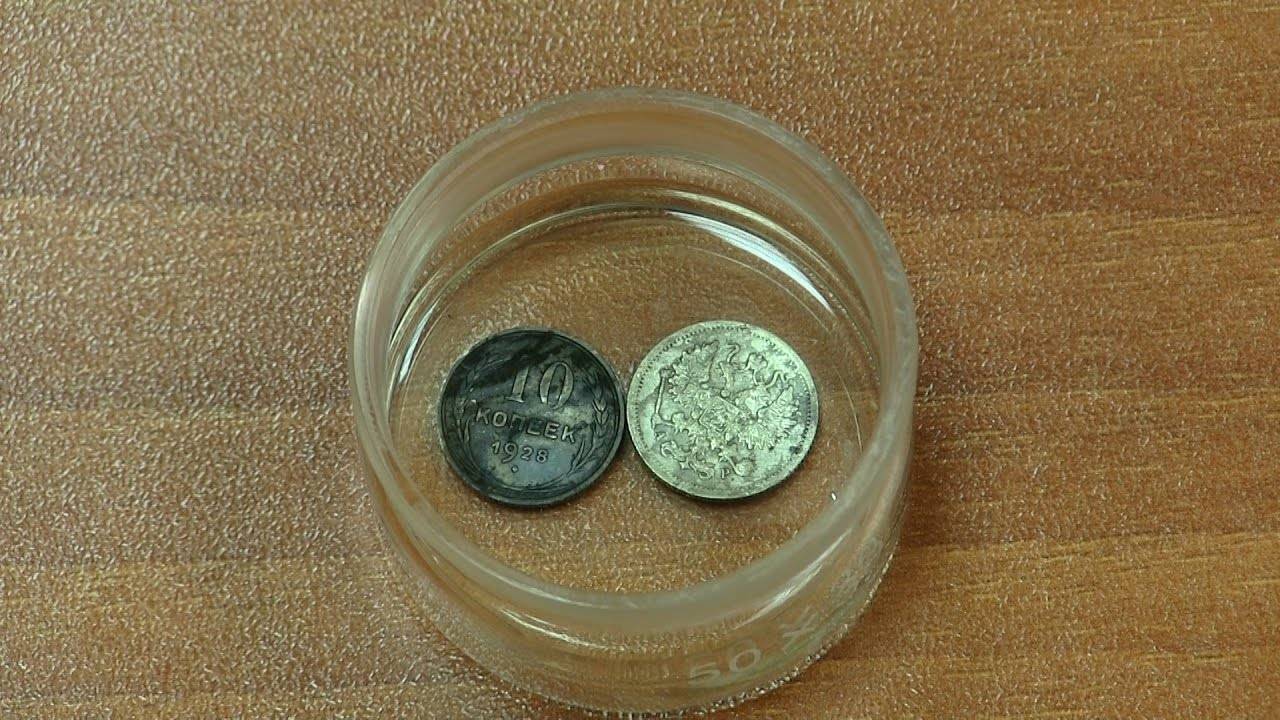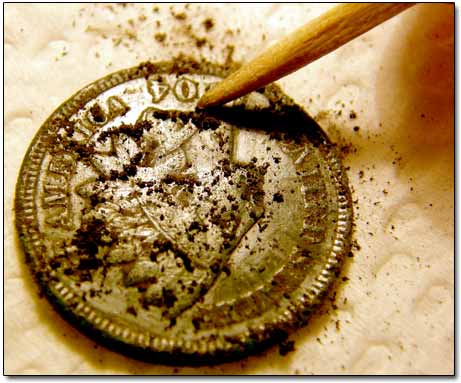How to clean a bimetallic coin?
A self-respecting numismatist knows that each type of alloy requires its own approach to cleaning. The most common problem is the state of the metals, when one part of the coin needs cleaning with anti-corrosion solutions, and the other is in good condition. And if ordinary cleaning with acidic solutions is applied to such cases, then there is a chance to harm the second metal, due to which such defects as tarnishing, a change in the chemical composition of the upper layer of the alloy, and a change in the basic color may appear on it.
That is why cleaning bimetallic coins at home may not give the desired results, but will definitely bring their surface to a better look. To carry out such procedures, you will need a soda solution (2 tablespoons per glass of hot boiled water). The coin must be placed in it for 15-20 minutes. Do not forget about the above remark regarding its placement in the container. Once removed, it can be brushed with white toothpaste without dyes. If there is none, you can use tooth powder. But it should be borne in mind that its abrasive particles can leave micro-scratches, so this procedure should be carried out very carefully so as not to damage the surface and not cause microcracks.
If the above method does not work well, you can try chemicals to dissolve limescale and corrosion. To do this, you need to apply a small amount of gel to the surface of the coin and wipe it thoroughly with a soft cloth. If the stains do not rub off, you can try the same steps, but this time using a toothbrush.
After these procedures are carried out correctly, the metal should acquire its characteristic color and luster.
Folk remedies
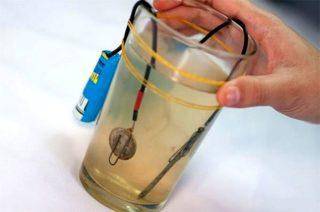 Cleaning a coin by electrolysis
Cleaning a coin by electrolysis
Cleaning nickel, aluminum and copper coins at home is possible with the help of available tools. These include:
- Soap solution is the mildest and safest for all metals. Soap (preferably baby) is rubbed on a grater, then diluted with warm water to a pasty state. A coin is immersed in this paste for several hours, periodically removing it and controlling the cleaning process.
- Citric acid - carefully dilute 1 teaspoon of "lemon" in a glass of warm water and dip a coin into the solution. Carefully observe the process by turning the disc over to prevent excessive exposure of the acid to the metal.
- Ammonia cleans copper coins well, but it is quite aggressive, so you need to act carefully. The object is immersed in an aqueous solution of ammonia for no more than one minute, while turning from one side to the other every 10-15 seconds.
Electrolysis is another common method for cleaning copper coins, but it is only suitable if there is no severe damage or cavities on the metal surface. Otherwise, all these shortcomings will become especially noticeable.
For the procedure, you will need a power supply. You can use an old mobile phone charger from which the plug is cut off. Then the wire is divided in two, and each part is exposed by 5-7 cm. Warm water is poured into the glass, in which salt or soda is diluted. The unit is connected to the network and the wires are lowered into the water. Near a positively charged wire, water begins to boil and hiss. Remembering the location of the plus and minus, the unit is turned off from the network.
A metal clip is attached to the negative wire - it will serve as a clip for attaching money. A metal object is attached to the plus.To avoid short circuits, the wires are bent to the sides and fastened with clamps to the edges of the container with saline or soda solution. After that, the power supply is connected to the network.
The electrolysis process lasts from 30-40 minutes to several hours. The system is then turned off and cleaning of the coin is completed with a sponge and detergent.
Avoiding oxides and rust on coins is easier than getting rid of them. To do this, you need not touch them with your bare hands, but use tweezers for this, and promptly clean collectible banknotes, avoiding their severe contamination.
Electrolysis method
This method is considered the fastest, but at the same time unsafe both for the safety of the products themselves and for the person carrying out the cleaning process. The restoration of the original appearance of the coins is carried out with the help of an electric current that passes through a slightly salted water solution where the product is located. The procedure should be carried out in a well-ventilated area with good lighting. You should prepare for the process. Safety glasses and gloves are the minimum preventive ways to protect yourself while working. When cleaning metal products by electrolysis, the risk of spoiling a valuable product increases.
In order to assemble an electrolysis apparatus, you will need a power supply with a low voltage of 6-12 V. Next, you should cut off the plugs and divide the wire into 2 equal parts in accordance with the existing insulation, cleaning its ends from insulation.
The copper veins of the wires are twisted, and metal clamps are soldered to them. To carry out the process itself, you need to take a plastic or glass container and fill it with a slightly soda or saline solution at the rate of 1 tbsp. l. 0.5 liters. The clamps are attached to insulated places at a distance from each other to prevent short circuits that could ruin the power supply, and then they are lowered into the water. After turning on the power supply, hiss and gas will be noticeable on one of the terminals. This is "+", the second is "-". The first connects to a coin, the second to any small metal object. Never immerse your hands in water without first making sure that the power supply is disconnected from the mains. This cleaning method is considered to be quite radical.
The second option is the reverse connection, that is, "-" is connected to a coin, and "+", respectively, to a metal object, for example, keys, a bolt or a nail. It does not affect the metal core of the product, from which it follows that the likelihood of spoiling a coin that is valuable to you is much less.
The electrolysis cleaning process, depending on the amount of contamination, can take from 2-3 minutes to 4 hours. After completing the process, unplug the power supply from the mains, and wipe the coins with a small amount of soap. If it is necessary to re-electrolysis, the salt solution is changed. When choosing this cleaning method, you must strictly follow safety precautions.
Cleaning products
There are many products available for removing oxides from copper objects. In most situations, available products are suitable for cleaning.
Table vinegar
Vinegar is used to remove stubborn dirt that has long been formed on the surface. The cleaning process is as follows:
- Vinegar essence is poured into bulky stainless steel dishes and edible salt is added.
- The container is put on fire and the product is placed inside.
- The mixture is brought to a boil, the heating is turned off and the container is kept on the stove until it is completely cooled.
- The object is taken out of the container, washed thoroughly under running water and wiped dry.
Liquid soap
In case of slight tarnishing, the surface can be treated with liquid soap. To do this, the soap is squeezed onto the surface and rubbed with effort into the contaminated areas. After finishing polishing, wash off the soap residues with clean water.
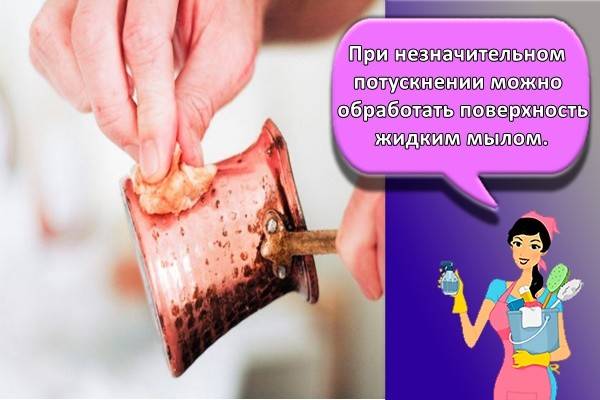
Citrus
For convenience, you can cut off half of the citrus fruit and rub the coating with it.After removing visible oxides and dirt, it remains to rinse the product with water.
Wine vinegar and flour
A common remedy is vinegar dough, for the preparation of which wine vinegar and flour are mixed in equal proportions. The ingredients are thoroughly mixed until a thick consistency is formed. The resulting mixture is applied to the surface of a metal object and left until a crust forms. Then the dried dough is peeled off and polished with a soft cloth.
Ketchup
Small items can be easily cleaned with simple tomato ketchup. You need to squeeze the ketchup into a deep container and immerse a copper object inside. After waiting about 10 minutes, you can remove and rinse the product.
Amidosulfuric acid
A solution of amidosulfuric acid effectively removes blackness and other types of contamination from copper items. To perform cleaning in an acidic solution, moisten a cloth and rub the surface until the desired result is achieved.
Lemon juice
At home, you can use freshly squeezed lemon juice for cleaning. A cloth is moistened in the juice and the product is wiped.
Soap solution
Subtle tarnishing can be easily removed with a soapy solution. Any soap is diluted in heated water, except for household soap (due to an alkaline composition), and then the oxidized areas are rubbed with a solution.
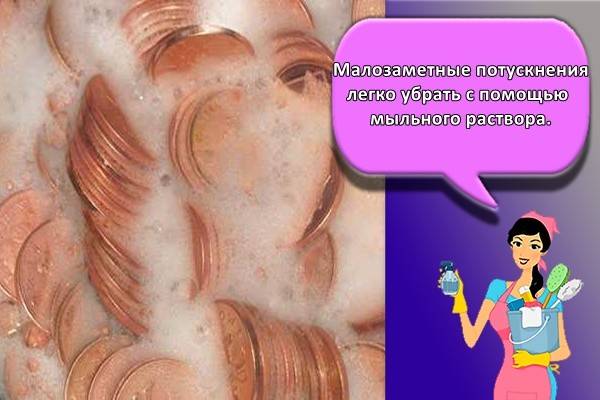
Dishwashing gel
Standard dish detergents are suitable for removing fresh oxides. The gel-like agent is squeezed onto a soft sponge, rubbed into the surface, and then washed with warm water.
Vegetable oil
Treating copper objects with pure vegetable oil effectively removes the formed plaque. After processing, the remaining oil can be washed off with clean water and soap.
Features of cleaning coins
Cleaning coins is a rather painstaking and delicate task that requires compliance with certain conditions. One of them is the metal from which the product is made.
Expert opinion
Evgeniya Taran
Therefore, before choosing a tool that will help you clean your collection at home, you should pay attention to the material from which it is made.
Copper
To successfully clean copper coins from green plaque and blackness, you can use the following methods:
- To quickly and effectively remove oxide from a copper coin, you need a fresh lemon. It is enough just to cut the citrus in half, and immerse the oxidized coins in its pulp for about twenty minutes.
- If you need to clean copper exhibits from dirt, a solution of shavings of solid soap in warm water will help. To carry out a hygiene procedure, you need to immerse the soiled products in a soapy liquid for fifteen minutes. After the specified time, it will be easy to wash them with plain water.
- Nine percent table vinegar will help effectively remove greens and blacks from a copper coin at home. To clean old coins, you will need to apply a little solution to a soft sponge, and gently rub the embossing until all dirt is removed. After the hygienic procedure, the cleaned exhibits must be washed with water and dried.
- Salmon can quickly remove dirt from a copper coin. First, apply the product to a cotton pad, then wash off the darkened surface, and rinse the product with water.
- To remove rust from coins from cupronickel, that is, from a copper-nickel alloy, you need to treat them with Asidol. With this tool, you can effectively clean any metal products.
Bronze
An old bronze coin can be cleaned in the following proven ways:
- Mix one hundred and fifty milliliters of water with citric acid in the amount of fifty grams, and immerse coins in the resulting liquid for fifteen to twenty minutes. After such a procedure, there will be no trace of rust.
- If the products have darkened, you must immerse them in olive oil heated in a small metal container and boil for five minutes. Then - remove the exhibits and clean them with ammonia.
- When you need to clean the bronze from corrosion at home, you can use any sweet soda. Usually Pepsi or Coca-Cola is used for such purposes. To tidy up old coins, you need to put them in a glass glass and pour a carbonated drink. For effective cleaning, you need to place the dishes in a warm place for two to three days, and then rinse with water. In this way, you can clean the coins to a shine.
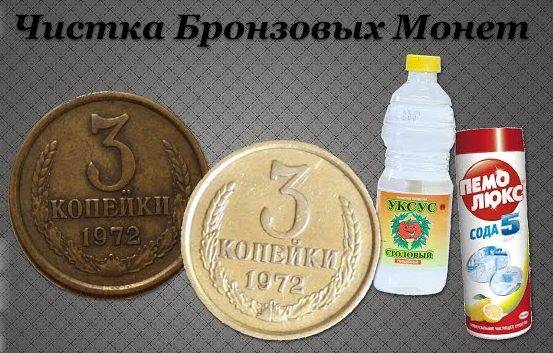
Bimetal products
Quite often, collectors have a question of how to clean bimetallic 10 rubles coins from contamination. There is one proven way to do this. To put bimetal products in order, you will need to sequentially perform the following steps:
- pour nine percent table vinegar into a small bowl, and immerse 10 ruble coins there;
- after two to three minutes, remove the coins and clean their surface with toothpaste;
- wipe the commemorative commemorative coins with a dry kitchen towel.
If it was not possible to clean ten-ruble coins from dirty deposits and rust the first time, it is allowed to repeat the hygienic procedure.
Storage after cleaning
After all procedures, the product must be wiped dry with a soft cloth and towel. Instances that are of value should be stored in a dry place away from sunlight and handled as little as possible. It is worth keeping each copy separately in special boxes, albums and so on.
If the patina is damaged during the cleaning process, then it can be applied artificially. It will give a noble look and protect against subsequent corrosion. Place the items in a solution of 10% hyposulfite for a few minutes, and they will be covered with patina again.
Different alloys require individual cleaning, therefore, before starting it, you should determine what metal the coins are made of, and follow the recommendations above. When carrying out these procedures, it is necessary to observe safety precautions.
I like not like
Acetic-salt way to clean coins
The best cleansing compounds, of course, are the helpers who can be found at home. Most folk remedies (for example, soap solution, citric acid) do not contain abrasive substances, therefore they do not so strongly affect the metal surface and does not spoil it.
However, you can also use chemical universal preparations that will effectively cope with any kind of contamination on the coin (for example, Asidol-M, Tech-45, Leuchttrum, Shine Coins, Silbo, Lan 7). Instructions for use, as well as on which surfaces a particular composition can be applied, is indicated on the package.
For silver
It is necessary to clean silver coins based on the probing and the degree of surface contamination. Instances of high-grade metal can be cleaned with soda (30 g of the substance will be required per 100 ml of water) or an ammonia solution (9 parts of water and 1 part of alcohol will be needed). The silver coin is simply placed in one of the solutions for a while until it clears.
If the oxidation is negligible on silver banknotes with a high purity, the surface can be cleaned with a mixture of soda, alcohol and toothpaste. The composition must be thick, and also there must be no abrasive in it. Apply the product to the surface and rub either with a brush or with your fingers.
Low-grade silver coins can be cleaned with a compound such as Trilon B. The product is mixed with water in a ratio of 1:10. After the product is dipped into the prepared solution. When the patina comes off the banknote, the coin can be rinsed with water.
For copper
Often the surface of copper specimens is covered with a patina.However, if there are no significant traces of rust, but there is simply a film, then it is better not to clean the copper metal disc. Patina protects the coin from rust, giving the piece a noble appearance.
If the coin is still susceptible to corrosion, it is necessary to use aggressive substances (for example, "Trilon B", citric and acetic acid). They will remove the deformed layer without affecting the integrity of the image.
Weakly oxidized specimens can be soaked in solution for several hours, and heavily contaminated ones can be left for a day.
To prepare a solution with citric acid, you need to dilute the powder with water in a ratio of 1: 3, respectively. To make a vinegar solution, stir a couple of tablespoons of vinegar in a liter of water.
For bronze
To restore the shine of the bronze surface, it is enough to grease the coin with toothpaste, and then wash it in warm water.
After washing, the banknote must be dried. To do this, the copy is wrapped in cloth folded in several layers, or a paper napkin.
For gold
There is no need to aggressively clean gold coins. If there is any contamination, they can be washed in warm soapy water, then rinsed and dried.
Gold coins do not need to be wiped clean with a cloth, as the cloth can scratch the surface.
For bimetal
The most effective means for cleaning bimetal banknotes are:
- Soap solution. Stir 30 ml of liquid dish detergent in a liter of warm water. Dip the coin into the composition for an hour. Then wipe the product with a dry, clean cloth.
- 10% ammonia solution. Pour the substance into a container and lower a coin there. Wait exactly 10 seconds, and then you can take out a copy with tweezers and wipe it dry.
You can use ammonia to clean proof quality coins. To do this, you need to hold on to the rim of the disc, removing dirt from the surface with light movements. The alcohol can be applied with a cotton swab. After the procedure, the coin must be washed and dried.
It is not difficult to clean a coin, including a dug one, from dirt at home. The main thing is to know for sure whether this tool is suitable for a specific type of metal or not, so as not to spoil the instance. If you are not sure, you can return the coin to an experienced professional for cleaning.
Mechanical cleaning
Cleaning copper coins is a rather laborious process that requires concentration, keeping the proportions in the preparation of solutions and aging periods. But as a result, you will save your finds and be able to replenish your collection with new items.
Mechanical cleaning is a special process of recovering coins in which the coin is rather not cleaned, but rather cut or restored in the oxide layer. For such a reading, the decisive moment is the experience and hard work of the master. A very primitive technology can be described as follows:
- The surface of the coin is desalted and cleaned from dried dirt in distilled water;
- All oxides, including loose ones, are strengthened by impregnating the surface in synthetic resin (paraloid B72);
- With the help of scrapers, cutters, brushes, needles of various hardness, the master removes from the surface everything that he considers superfluous. By fixing unstable areas, they do not fall through and can be aligned with the main field of the coin and no cavities remain. All work is done under a microscope.
| These 4 kopecks from 1762 were cleaned by a professional using mechanical cleaning technology. The result is simply excellent, but such processing of the coin took a very long time (2 months for this coin) and is relevant only for rare and valuable coins. |
Using home remedies
Lemon acid
This type of cleaning is carried out under constant control. In the process, it is better to remove the coins several times and check their condition to prevent damage.
Coins are cleaned with citric acid if there are various contaminants on the surface of the product that could not be removed in soapy water.
In order for the solution to help get rid of oxides, but not harm the metal, its concentration should be no more than 10%, that is, 10 g of citric acid falls on 90 ml of water. The coins are immersed in the resulting solution, periodically turned over and checked, and then washed under clean water.
Soap solution
This is the most gentle option and is often used as a first step in cleaning. However, it can drag on for several months. The method is based on the fact that the soap solution is a slightly alkaline medium, which contributes to the gradual softening of oxides and other contaminants. The smallest alkaline environment is imposed on baby soap, and the largest is on household soap. The former will be preferred when handling copper coins.
 Cleaning coins in soap is the most common method, and all due to the fact that it is one of the most delicate and affordable methods.
Cleaning coins in soap is the most common method, and all due to the fact that it is one of the most delicate and affordable methods.
The cleaning process is as follows:
- Grate or finely chop the soap, then cover with hot water. You should get a viscous, jelly-like mixture.
- Place coins in the solution. They must be completely covered with the composition and not in contact with the walls of the container and with each other.
- Stir and turn coins periodically.
- After the end of soaking, the specimens are cleaned with a soft brush and rinsed with warm water.
The soap leaves a characteristic white coating that can be easily removed with baking soda.
Vinegar and toothpaste
A versatile product that helps get rid of oxidation and rust. To do this, you need to mix table vinegar and paste in a 1: 1 ratio. The resulting mixture is rubbed over the surface of the coin in a circular motion, after which it is washed off with cold water.
 Rub the items with a brass brush and rinse off the remaining solution from the surface with warm water.
Rub the items with a brass brush and rinse off the remaining solution from the surface with warm water.
"Coca Cola"
The drink contains a small amount of phosphoric acid, which removes minor impurities. To do this, the coins must be placed in soda, poured into a transparent non-metallic container, for several days. The liquid can be heated slightly to speed up the reaction.
 Many people know that this drink has some cleansing effect and is useful for glossing.
Many people know that this drink has some cleansing effect and is useful for glossing.
Baking soda
To clean the coins, they are boiled in a soda solution consisting of half a liter of water and 3-5 tablespoons of dry matter. Instances are immersed in liquid and digested for half an hour.
 For copper coins, soda is considered a fairly gentle cleaning method.
For copper coins, soda is considered a fairly gentle cleaning method.
"Oil" boiling
The method is quite effective and allows you to wash off the patina. For it, olive oil or vaseline oil is used, which is poured into a metal pan or deep fryer and heated. Coins are dipped into the hot liquid and boiled for ten minutes, after which they are washed with soap and a soft brush.
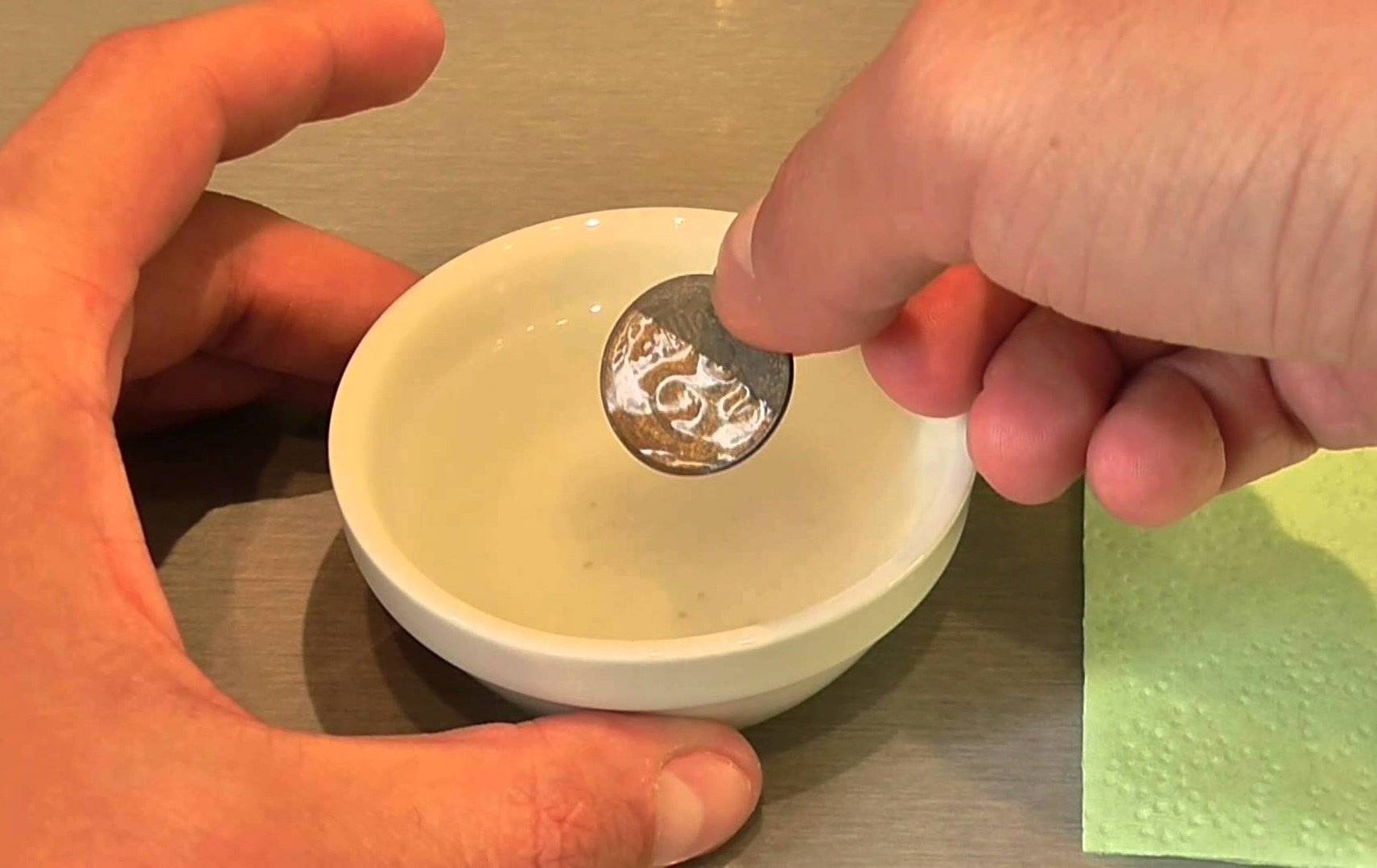 Heat vaseline or vegetable oil in a water bath. Dip the change in hot liquid for 10 minutes.
Heat vaseline or vegetable oil in a water bath. Dip the change in hot liquid for 10 minutes.
Note! In some cases, additional boiling in clean water is required to remove oil residues.
Citric acid cleaning
In order to prepare a solution in which we will clean copper coins (other copper objects covered with oxides), it is necessary to grate soap (preferably household or children's) and boil with boiling water. After an hour or two, the solution will begin to thicken and take on the consistency of ketchup or toothpaste.
Coins are immersed in the prepared solution one at a time so that they are evenly covered with soap before they stick to the bottom of the can. Coins remain in solution for at least a day, and for a week. Next, the coins are taken out and washed with warm water, the plaque on the surface is cleaned off with a toothbrush with a bristle cut for rigidity.
If the green ones remain, then the process must be repeated. The soap solution can be used several times.As a rule, the coin is not cleaned the first time. In the best case, cleaning takes a week, during which the coin has to be removed from the soap 3-7 times. Dense oxides are possible, which are cleaned within six months.
After the coin is completely cleaned of oxides, it must be cleaned with baking soda with the same toothbrush, this is necessary so that the white plaque from soap does not remain on the coin, which gets into the pores and spoils the appearance.
| Two pennies in 1901 were cleaned with soapy water. The total time in the soap was about a month. |
| Two pennies in 1882 were cleaned with soapy water. The oxides were less durable than in the first example and were removed in 10 days. |
And at the very end, before sending it to the album, you can rub the coin with petroleum jelly. This will slightly improve the appearance and to some extent preserve the coin.
For copper, citric acid is a highly destructive reagent and should be considered a lot before using it. As a result, it is possible not only not to improve, but also greatly worsen the appearance of the coin and its value. At the same time, citric acid is one of the best options for cleaning silver coins.
| The penny of 1875 looked quite ordinary before cleaning with citric acid, but the cleaning process can hardly be called that, the coin was practically destroyed in a few minutes in acid. |
The method is brutal enough for copper coins, as it degrades the surface decently. But for the case when the coin is unevenly coated with a very strong green oxide that does not take the soap, ammonia can be used.
| This penny of 1903 was expropriated for 10 names. The result is certainly not great, but very persistent oxides were quickly removed. |
The cleaning process itself consists in the fact that the coin is completely immersed in ammonia, kept there for another minute, then taken out and cleaned with a toothbrush. Since the ammonia corrodes oxides very quickly, it is better to remove and clean the coin more often, it is also worth putting it on different sides each time.
A fairly simple and quick technique for cleaning copper coins. The name itself almost completely describes the technology. Copper coins are boiled in a solution of soda and water. The solution is quite concentrated: 3-5 tablespoons of baking soda for half a liter of water. The solution should cover the coins by 2 cm. This is to prevent the coins from coming out of the solution during the cleaning process. The cooking itself should be continued for 30 minutes. Then take the coins out of the solution and clean them with a toothbrush with gruel of the same soda.
| A penny of 1910 was cleaned in 30 minutes of boiling in soda. The result is not bad enough: green oxides were completely removed and the patina layer was not damaged. The fact that irregularities and cavities opened on the field of the coin is rather a defect of the coin itself and this negative effect from cleaning could have occurred with any other method. |
The method allows you to clean copper money from stains, plaque and other contaminants. You will need:
- Baking soda 3-4 tbsp. spoons.
- Water 0.5 liters.
Mix the ingredients, immerse the coins in the container and put it on the fire. The solution should cover the coins by no more than 2–3 cm. Boil and simmer the coins for about 30 minutes. Then clean them with a toothbrush using soda gruel.
What not to do
barbaric methods
1. Mechanical cleaning by rubbing with a rag, carpet, etc. (in common parlance - "cleaning with a felt boot"). Sometimes GOI paste (green, like plasticine) can be used, but it only aggravates the damage to the coin. GOI paste can only be used on certain types of jewelry (non-antique), where gloss is of paramount importance. In general, its main purpose is to clean optical lenses. 2. Rough dry cleaning with acids and other aggressive compounds. In addition to removing dirt and oxides, part of the surface disappears, bumps and dents are formed. Any acids should be diluted with water (preferably distilled) in a ratio of at least 1 / 7.3.Scratching the coin with metal or other objects to remove a layer of dirt. In this case, the surface is irretrievably damaged, scratches and dents appear. The method can only be used to remove adhered dirt, and only with a wooden object (for example, a toothpick)
If the coin is not valuable, you can use a toothbrush, but with extreme caution.
Basic alloys and metals
Usually products are minted from several metals. Each type has its own most suitable cleaning method.
- The most expensive metal is platinum. First released in the Russian Empire;
- Gold money began to be produced practically from the time of its invention;
- Silver copies have been produced since the 6th century BC;
- Copper has been used for minting since antiquity;
- Tin is used as a constituent of alloys;
- Nickel change coins began to be produced in 1850;
- Zinc money has been made since World War II;
- Aluminum money appeared at the end of the First World War;
- Iron money began to be issued as early as the 16th century BC;
- Bronze.
Cleaning can be done both mechanically and chemically.
Cleaning with bristle brushes of varying degrees of hardness is called mechanical cleaning. It is strictly forbidden to use metal objects in this case.
In this way, dirt and dust are cleaned, acting with care so as not to damage the surfaces.
In the case of extensive contamination, dry cleaning with various oxides is used, which differ depending on the material of manufacture.
Drying coins after cleaning
Regardless of the home cleaning method chosen, coins must be properly dried to prevent re-corrosion.
The easiest way is to wipe the cleaned items dry with a soft cloth, microfiber or flannel will do. Rubbing the surface intensively is not recommended, as even the most delicate material can leave scratches invisible to the eye.
It is recommended to wrap bronze specimens first in a thick paper towel, and then in a clean cloth. This will be enough to absorb the excess water.
There is a simple method for knowing that the coins are clean and ready to dry. They need to be put in water, and one drop of azoic acid silver solution should be added. The water should remain clear.
Collectible items can be dried in a special drying cabinet at a temperature of 100 ° C.

